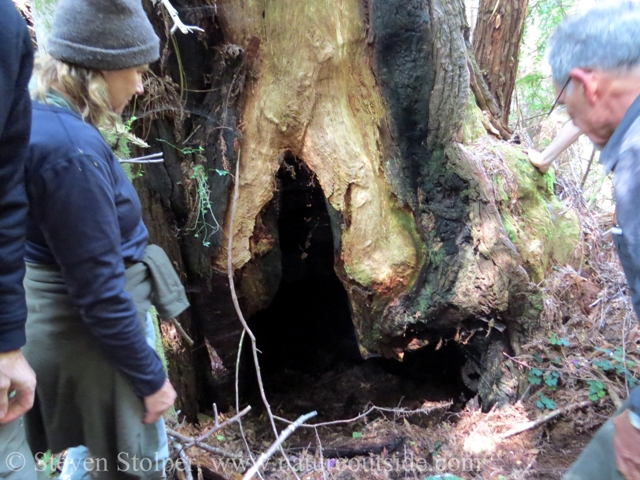
How often do you get to follow a bear? For me the answer is never! So imagine how exciting it is to learn to trail them. In Part 1 we discussed Marble Mountain Adventures bear trailing class. We also talked about Black bear behavior and how we established our base camp along the ocean. Now, it’s time to trail bear!
Tracking vs. Trailing
Animal Tracking uses the signs animals leave behind to deduce their comings and goings. You “read the newspaper” of the forest by observing subtle clues in the soil, plants, and rocks.
Tracking reminds me of a visit to Carnegie Hall as a child. I walk down an isle of the cavernous auditorium straining to hear the last note of a symphony. But the hall is empty, the musicians long gone. I can sense the ghosts of the last concert but I can’t hear the music.
Trailing an animal is like following the musicians home and demanding another performance! You come across an animal’s tracks and follow them in a quest to find the animal itself. The challenge is to follow the animal wherever its tracks may lead. This requires keen powers of observation, deep concentration, and the doggedness to pick up the trail when it runs cold.
Meet the Guides
Our guides are Preston and Matt.
Preston orients us and explains the signs we see. He helps relate them to bear behavior. Preston holds a degree in Wildlife Management & Conservation as well as a Cybertracker Certification. He has done fieldwork with Black bear, River otter, bobcat, puma, and Gray fox. Preston also spent time in Canada working with puma and lynx.
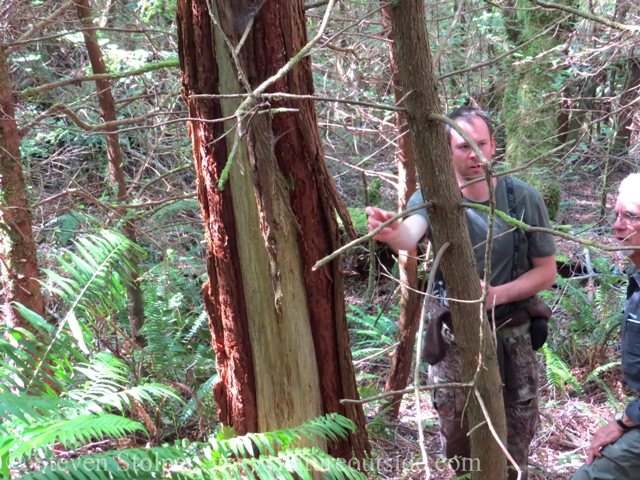
Preston explains the sign and relates it to bear behavior
Matt towers above the rest of us. His reserved demeanor belies his powers of observation. Whenever the trail runs cold, Matt helps us recover it. His presence is reassuring. He waits patiently as we scout for telltale signs of where the bear went next.
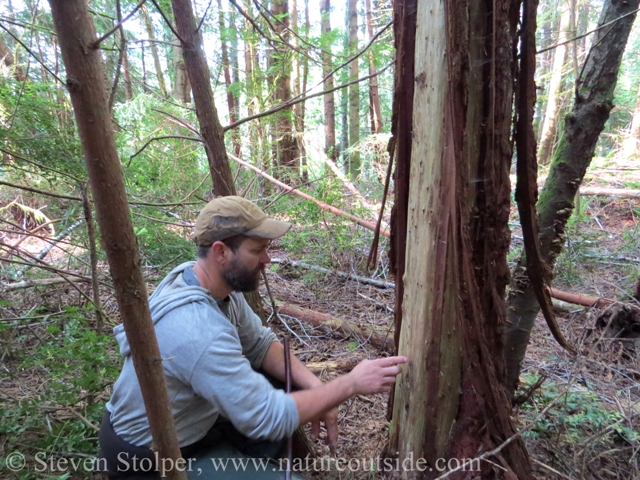
Matt explains a detail about this feeding sign
Both guides wear earth tone clothing and carry stout cudgels. Aside from my can of bear spray, their sturdy walking sticks are our only protection against an aggressive bear. They use their staffs to indicate sign and part tangled branches as we slide through dense thickets. Before long many of us commandeer downed redwood limbs for the same purpose.
Off we Go
Preston and Matt formulate a plan. We climb a hiking trail as it ascends a hillside underneath redwood forest. They know there is bear activity here and hope to encounter the tracks of a bear crossing the trail.
The hiking trail wends its way through Sitka spruce, Alder, and impressive Redwood trees. Looking skyward, I get the impression I am floating along a river carving through the dense forest canopy. We ascend the trail for only a mile before we encounter bear sign.
Feeding Sign
The first sign we encounter is feeding sign. It is pretty dramatic.
In the spring, bears feed on the sap-rich cambium layer of trees. The carbohydrate rich sap helps them regain weight lost during the winter. The inner bark of trees is one of the few food sources available in the early spring.
The pictures below show that bears have fed on the inner bark of redwood trees. Bears sometimes kill trees by girdling them. For this reason some lumber companies in the area allow bear hunting on their land.
Preston explains that the sap starts flowing about a day after the bears feed. We see new wet sap, which implies the bear fed here just over a day ago.
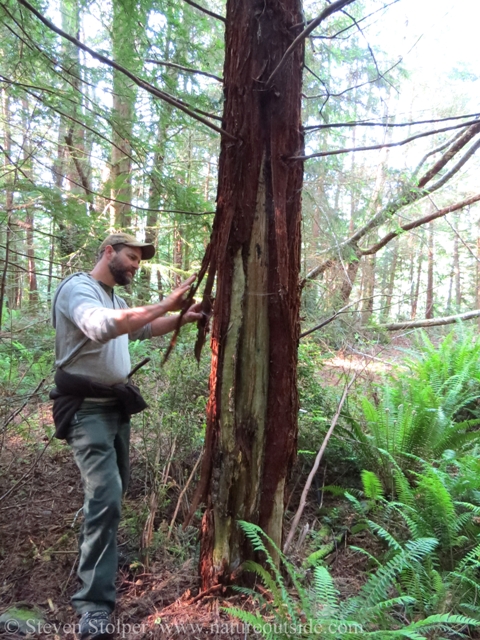
The bear stripped the outer bark of this Redwood tree to eat the inner bark (cambium layer) underneath
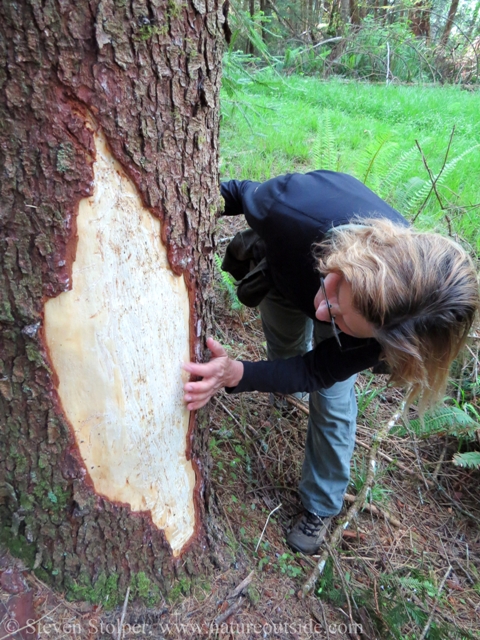
Feeding sign is hard to miss if you look for it
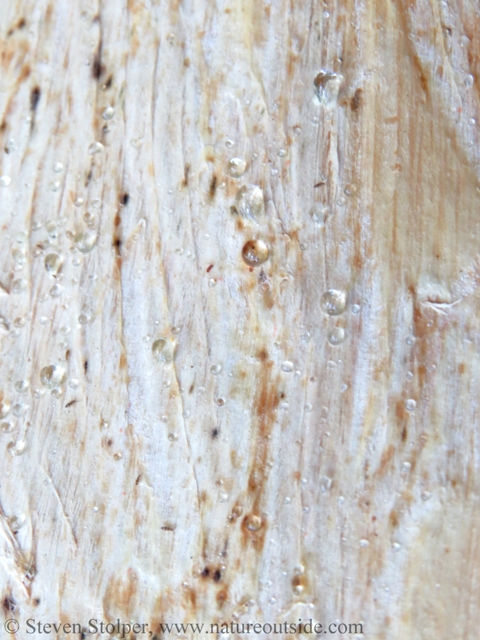
The sap starts flowing about 24 hours after the wound. This tree was barked recently.
In these pictures, you can see the parallel gouges left by the bear’s canine teeth. The bear is scraping the inner bark from the hardwood.
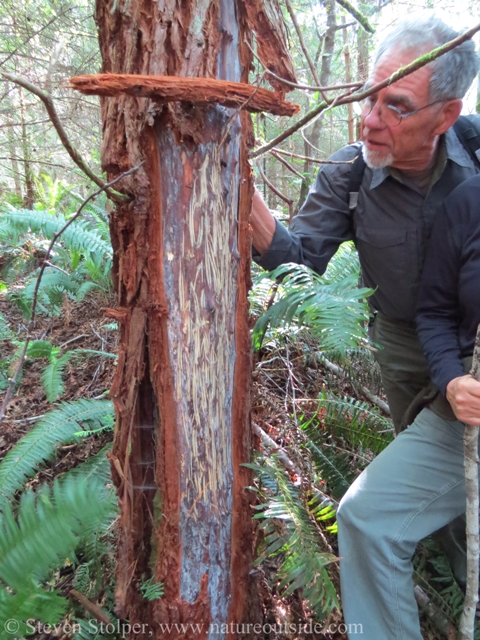
In this feeding sign, you can see the gouges left by the bear’s canine teeth
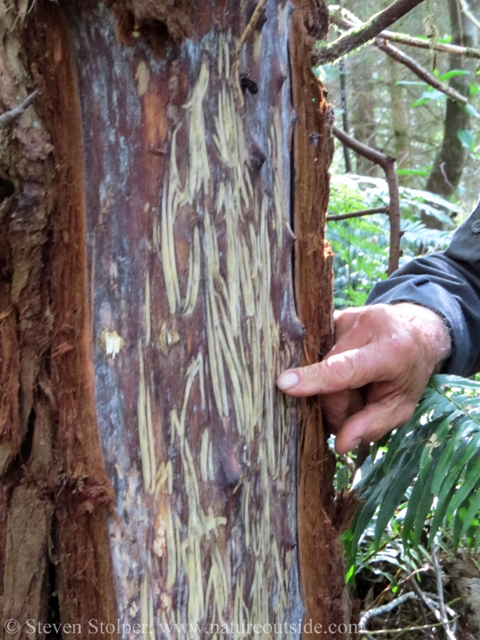
A closer look at the gouges left behind by a feeding bear
We also saw that the bear was feeding on grass growing on the trail.
Marking Sign
Nearby we see marking sign. Bears mark trees to communicate with other bears. It is not clear how the communication works. But they leave visual and olfactory information for other bears that pass by.
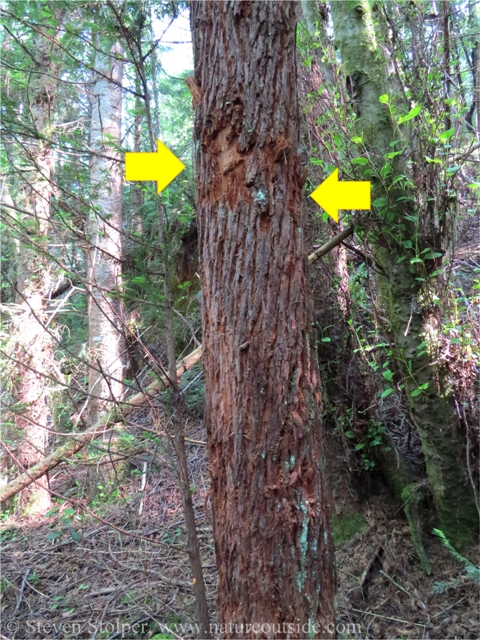
Many times the bear stands on its hind legs to mark the tree. Notice how this differs from feeding sign.
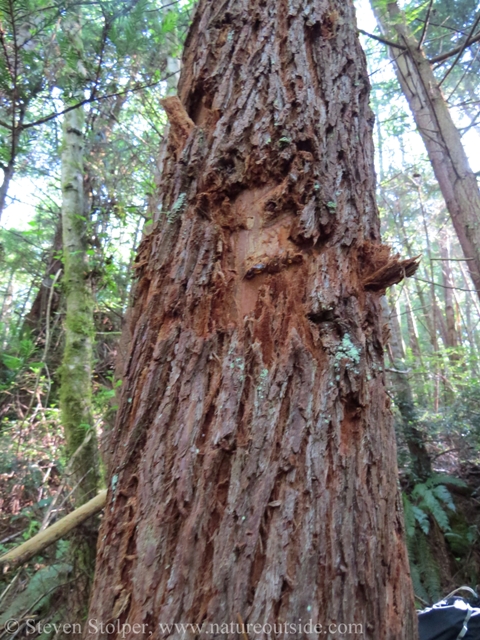
Marking sign is distinctive and looks very different from feeding sign. (Redwood tree)
The bears stand on their hind legs with their backs against the trunk of the tree. They turn their shoulders and bite and claw the tree. To leave scent they shimmy up and down the tree, rubbing their backs against the trunk. Here is a hysterical video of bears doing just that. Thank you scientists at the USGS Northern Divide Bear Project! You guys have a great sense of humor.
Here is a sow with cubs doing it.
I was aware of this marking behavior before taking the class. So whenever I saw signs of it, I inspected the tree closely looking for hairs the bear may have left behind.
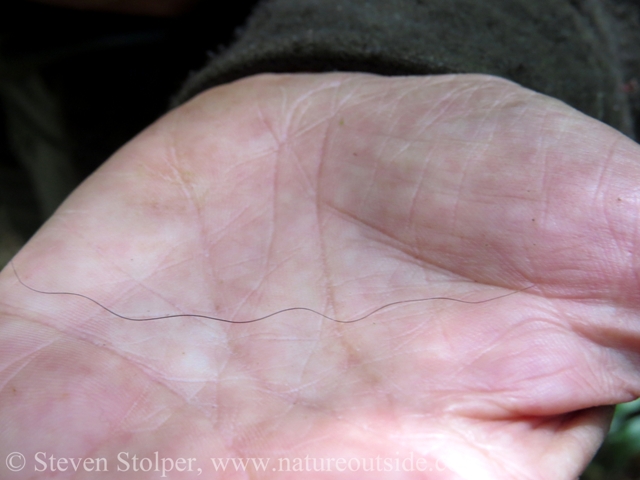
A bear hair I removed from the tree
Redwood Forest
We decide to follow the bear trail. At first it’s easy. The trail is overgrown with grass and we clearly see where the bear crossed the trail after feeding. The blades are pushed down in the direction of the bear’s travel and the trampled foliage “shines” back at us, indicating the way.
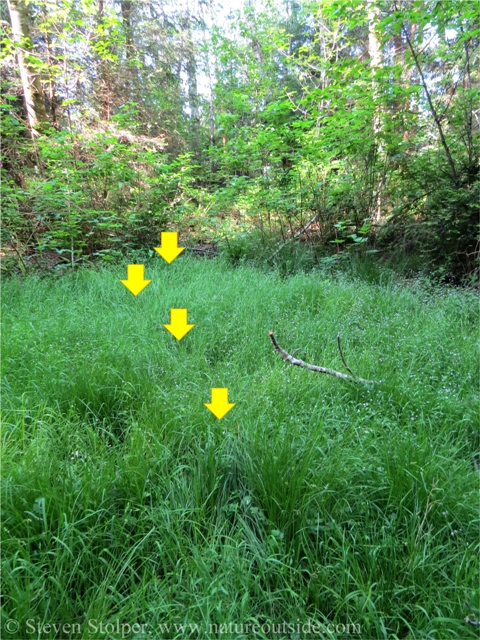
It is harder to see the bear’s trail in this photo than it is in person
Two of us run “point.” Under Matt’s watchful eye, we track the bear while Preston and the remainder of the group follow behind. After a while, the two trackers running point swap with their classmates shadowing from behind. So each of us has the chance to lead the pursuit.
Talking is kept to a minimum. Nothing spooks a wild animal like the sound of a human voice. Matt and Preston communicate with gestures. When we speak, we use hushed tones.
We try to move silently through the forest. Seven people wearing hiking boots can create quite a commotion. So we move deliberately. We avoid snapping twigs and replace branches as we creep so they don’t snap back with a crash.
Tracks in the Redwood Forest
The trail descends the forested hillside. Underneath the redwoods there is little understory. So we move easily through the open forest. Downed trees and occasional huckleberry bushes requires us to detour, crawl or shimmy underneath hem.
The forest duff does not yield clear tracks. Instead, you see irregular oval shapes. Their cumulative effect is to create a “path of disturbance” through the forest. What surprises me the most is how lightly the bears walk. I expect broken twigs and trampled foliage inside their footprints. But what I see is woodsorrel and other green plants untouched inside their tracks. This confused me until I came to grips with it.
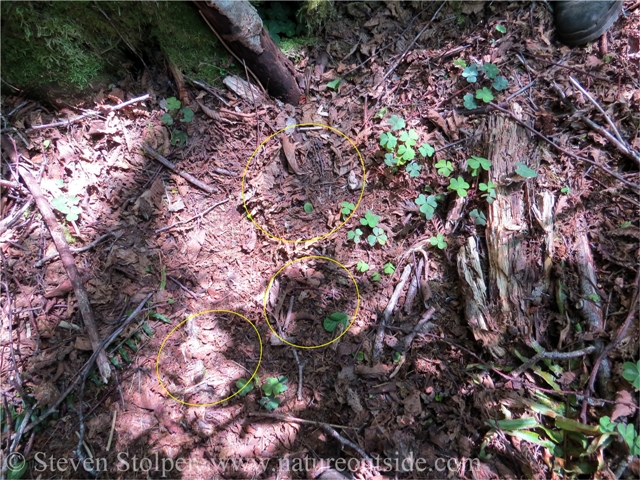
In the duff, the tracks become vaguely defined ovals. At this resolution it is hard to see them. You follow the path of disturbance through the redwood forest
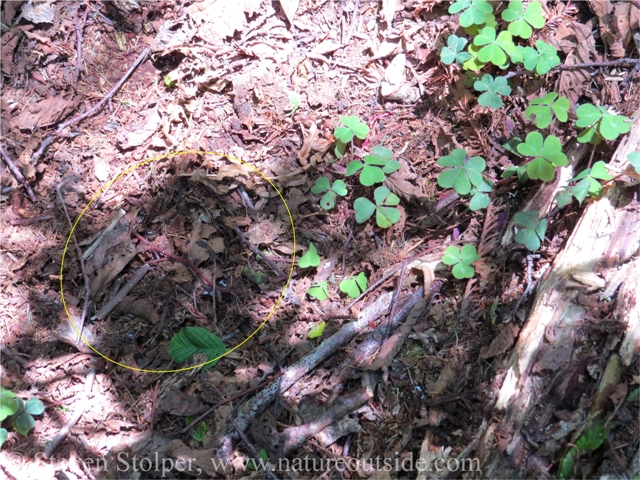
A closer look at one of the tracks. Can you see the “ridge” created at the front of the track? (right side of oval)
In this difficult substrate, it is easy to lose the trail. We lose it right off the bat and I end up leading the group onto an older trail. Even after we recover the fresh trail, we often lose it again. This can be frustrating at times.
The way we recover the trail is to retrace our path to the last “good” track we saw. Then we cast in all directions until we find the trail. Bears still have to obey the laws of physics. And all ground animals leave some trace of their passage. So it is a matter of searching, and searching, until we are back on the trail.
This also impresses on me the importance of remembering our past moves. Often we retrace our steps to find the last good track. If you remember where you saw it, the process goes much faster.
In one case, we search for quite a while before realizing the bear made an abrupt turn. We follow the tracks to what appears to be a lair.

The tracks went in and out of this hollow redwood tree
After checking to assure ourselves it was unoccupied, Preston and a student went in with flashlights.
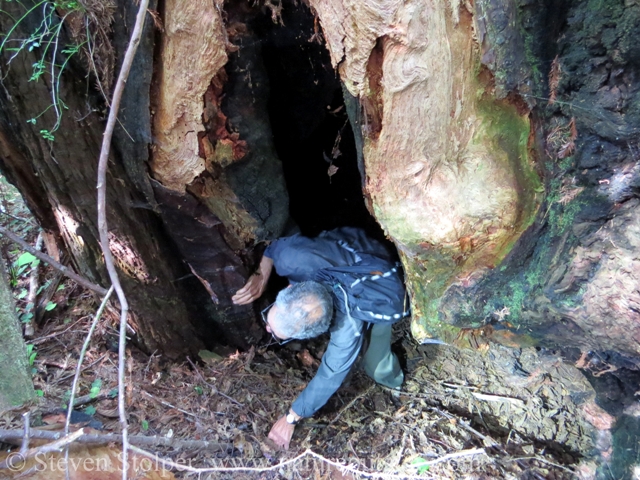
Descending into the tree
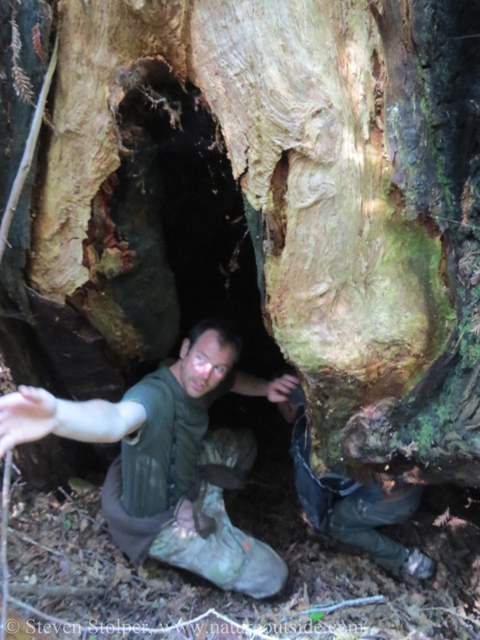
Where the bear goes, so do we
We did not find anything interesting inside, so we picked up the trail leading away from the tree. We followed the fresh bear trail down the mountainside. After a while, it became clear it was heading for a swamp below us.
Stalking the Black Bear – High Adventure in the Forest (Part 1)
Stalking the Black Bear – High Adventure in the Forest (Part 3)
Stalking the Black Bear – High Adventure in the Forest (Part 4)
Other Tracking Articles on NatureOutside
Mountain Lion Tracks – Learn to Read Them
Mysteries on the Beach (Part 1)
Wolves Teach a Master Class (Part 1)



Good stuff! I found an empty den when I lived in NY. Down the creek a bit, I looked, and there was mama and cub on a large rock in the water. THAT was the first time I ever actually saw them in the wild. It’s amazing for sure to see animals so closely. I hope to learn more through these recoded experiences. Thank you!!!
Vicki, I’m glad you enjoyed the article. It really is amazing to see animals up close in their natural habitat. When we see animals going about their lives in the wild, it’s a glimpse into a secret world few are privileged to see.